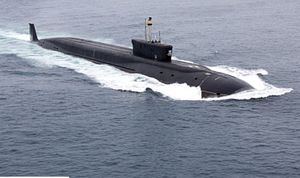The nuclear-powered ballistic missile submarine (SSBN) Knyaz Vladimir (Prince Vladimir), the Russian Navy’s first upgraded Project 955A Borei (A) II-class (“North Wind”) or Dolgorukiy-class boomer, will likely be commissioned in April or May of this year, according to a Russian defense industry source.
“The Knyaz Vladimir is expected to be delivered to the customer by the Victory Day. Most probably, in April,” the source was quoted as saying by TASS news agency on March 3. Neither the Russian Ministry of Defense (MoD) nor Sevmash shipyard confirmed the purported commissioning date.
In February, the head of the United Shipbuilding Corporation (USC), Alexei Rakhmanov, said that the boomer will likely be delivered to the Navy in March or early April. “I think another month and a half is needed,” Rakhmanov was quoted as saying by Interfax news agency on February 10. Rakhamanov added that that sea and weapons trials of the new SSBN have been completed: “All the finishing work has been done and the trials are over.” Another anonymous Russian defense industry source said in December 2019 that the Knyaz Vladimir would be delivered to the Russian Navy in the first half of 2020.
The Knyaz Vladimir was laid down in 2012 and floated out in 2017 with a two-year delay. As I noted back in February:
The boomer was originally expected to be commissioned by the end of 2019. However, the latest round of sea trials in November of last year revealed a number of deficiencies that needed fixing.
The Borei-(A)-II-class boomer’s initial round of sea trials reportedly began in late November/early December 2018 and finished in January 2019. The second round kicked off in early July 2019 and lasted until November of the same year.
The Knyaz Vladimir also conducted weapons trials during that period. The SSBN has for the first time test fired a RSM-56 Bulava (NATO reporting name: SS-N-32) submarine-launched ballistic missile (SLBM) in October 2019.
As I explained back in 2o19:
The Bulava SLBM–a sea-launched variant of the Topol-M—can reportedly be fitted with six to 10 nuclear multiple independently targetable reentry vehicle (MIRV) warheads yielding 100 to 150 kilotons apiece, as well as 10 to 40 decoys. The three-stage solid propellant (with a liquid head stage) Bulava has an estimated range of over 8,300 kilometers (5,157 miles).
Borei-(A)-II-class SSBNs have upgraded stealth capabilities, better underwater maneuverability, and can carry extra SLBMs in comparison to the baseline Borei-class. The Russian Navy currently deploys three baseline Borei-class SSBNs. The Yuri Dolgoruky is in service with Russia’s Northern Fleet, while the remaining two Borei-class SSBNs – Alexander Nevsky and Vladimir Monomakh — serve in the Russian Navy’s Pacific Fleet.
































